Article by Alison Hugill in Berlin; Tuesday, Aug. 19, 2014
Venice is at its tourism peak in the summer months, and the Biennale – a bit of a misnomer given that the art and architecture events alternate each year – draws a large international crowd. Even two months after the opening, the Arsenale and Giardini exhibition halls are abuzz with visitors.
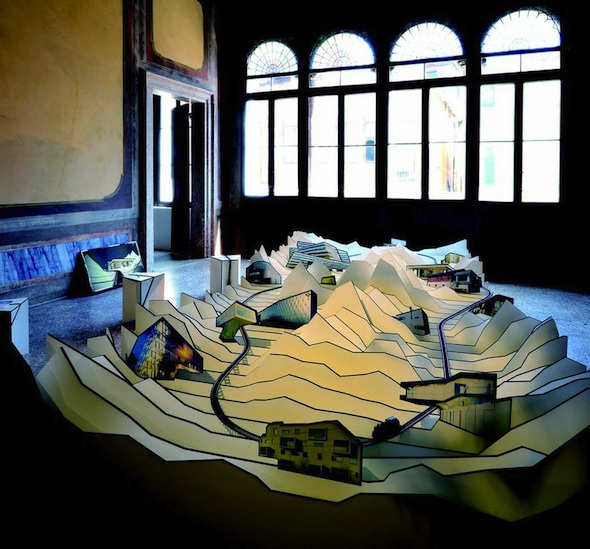 Caramel, Under House H, 2013. Installation view at Palazzo Mora, Venice Architecture Biennale, 2014. Photo: Global Art Affairs Foundation
Caramel, Under House H, 2013. Installation view at Palazzo Mora, Venice Architecture Biennale, 2014. Photo: Global Art Affairs Foundation
On the periphery of the 14th Architecture Biennale’s main venues, a Dutch non-profit organization called GlobalArtAffairs has set up residency in several of the city’s abandoned and disused palaces. In the Palazzo Mora and Palazzo Bembo, their exhibition TIME SPACE EXISTENCE complements Koolhaas’ Fundamentals with its own take on the tenets of human life, from an architectural perspective. The show is comprised of projects by more than 100 architects from 40 countries, and takes up two Venetian palazzi.
Despite being slightly off the beaten Biennale path, the extensive exhibition didn’t stray far from the expected. A good site-specific analogy can be found in one of the national displays in the Giardini: the Russian pavilion’s Fair Enough enacted a tongue-in-cheek commercial art fair in their space, branding different architectural trends presented by 20 fictional offices. Each cubicle, curated by educational institute Strelka, presents an aspect of Russia’s architectural modernization in the form of a well-packaged and over-the-top branded presentation.
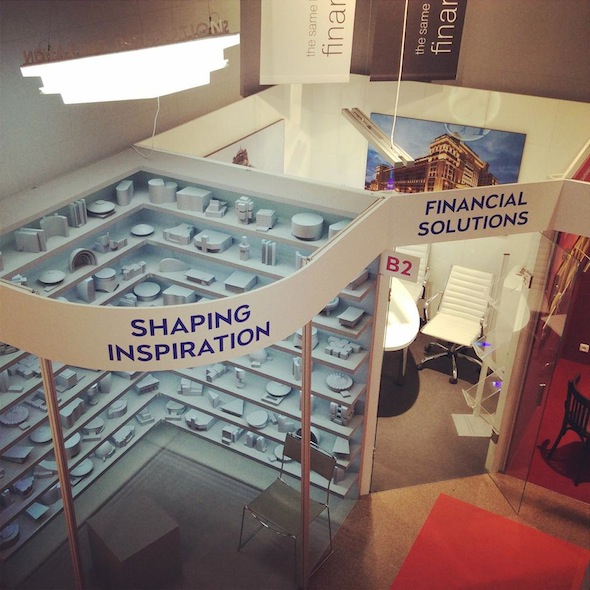 Russian Pavilion, Installation View, 14th Venice Architecture Biennale; Photo by Alison Hugill
Russian Pavilion, Installation View, 14th Venice Architecture Biennale; Photo by Alison Hugill
Unintentionally, TIME SPACE EXISTENCE feels like a similar display, but without the biting irony that made the Russian pavilion a success. For the most part, the international offices chosen to present in the TIME SPACE EXISTENCE exhibition were haphazard, with little curatorial distinction between established and emerging architects. This kind of democratic selection process is not to be reproached, but a less vague theme might have made the participants’ inclusion more coherent. Instead, the vast exhibition ended up resembling an architectural trade fair in some ways. The theme of ‘Time, Space, Existence’ left wide open the possibilities for presentation, with the predictable result that we were faced with the absence of any meaningful guiding thread.
The catalogue is a good indicator: in the introduction to the exhibition, one of the organizers from GlobalArtAffairs admits that the foundation is new to architecture, and that they are mostly used to curating art shows. The introduction is riddled with marketing jargon, providing very little conceptual understanding: “by highlighting the concepts of TIME SPACE EXISTENCE, we can have a positive influence on other people, making them more aware about their existence as human beings within time and space.”
Fortunately, many of the projects, and the intriguing exhibition spaces themselves, provide the aesthetic backdrop for a worthwhile visit. In the Palazzo Bembo, located next to the famous Rialto bridge, Numen / For Use have collaborated with lighting experts Balestra Berlin to create a mind-warping installation. The piece uses simple techniques and materials – mirrors and vibration – to create an infinite optical illusion. On the upper floor, German architecture firm GMP – Von Gerkan, Marg and Partners present two Berlin airport constructions from the last century: Berlin Tegel and the much discussed Berlin Brandenburg. While GMP designed both buildings, the comparison is almost comical, given the endless setbacks and postponement of the BER construction. In this display, the architects present both airport projects as beacons of “truthfulness” and people-friendly design. Unfortunately, BER-Berlin Brandenburg has yet to welcome any of these venerable “people” into their building, nor do the prospects look likely at this point.
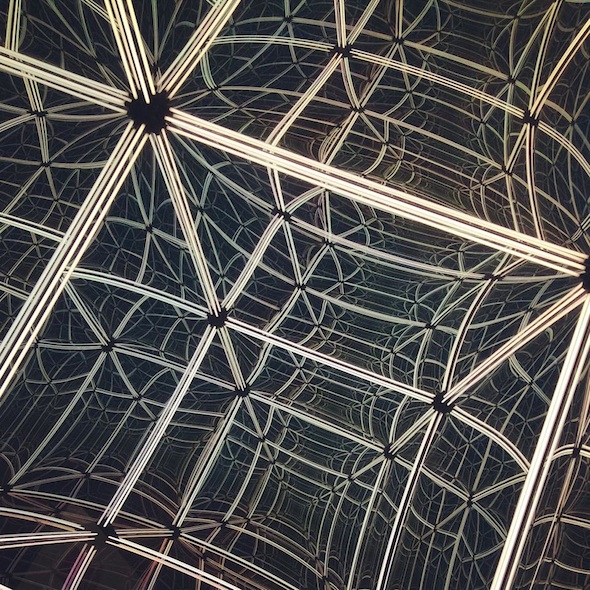 Numen / For Use – N Light Membrane, Installation View Palazzo Bembo; Photo by Alison Hugill
Numen / For Use – N Light Membrane, Installation View Palazzo Bembo; Photo by Alison Hugill
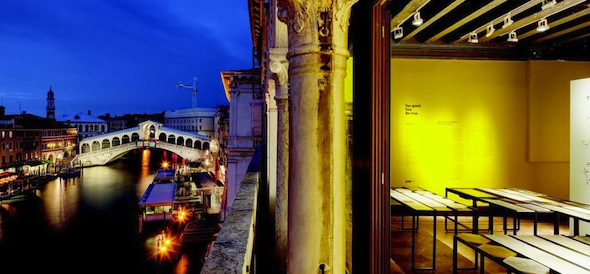 gmp, Too good. Two. Be true. Blueprints for the future: the airports Berlin-Tegel and Berlin Brandenburg by the von Gerkan, Marg and Partners Architects. Installation view at Palazzo Bembo, Venice Architecture Biennale, 2014. Photos: Marcus Bredt
gmp, Too good. Two. Be true. Blueprints for the future: the airports Berlin-Tegel and Berlin Brandenburg by the von Gerkan, Marg and Partners Architects. Installation view at Palazzo Bembo, Venice Architecture Biennale, 2014. Photos: Marcus Bredt
In the Palazzo Mora, the renovations of the building – completed gradually from bottom to top – take centre stage. At the top of the building, the unfinished floor is being investigated by Italian architect Florencia Costa in his installation “Who’s Afraid of Architecture?” Costa has left the space largely untouched, adding only subtle accents to highlight its disuse and reappropriation. It’s thrilling to walk through the upper levels and see how the palace looked before its restoration. According to the designer, the “top floor is urbanized with work-living cells for art residents anchored along a labyrinth scheme of narrow passages or Calli.” The effect is quite haunting, displaying a visceral connection to the history of the building through its raw and exposed materials.
One architecture office from London, Chance de Silva, has created an investigation of homelessness in Europe as part of their installation, which is located in a dilapidated room in the palazzo. The developer/architecture firm tries to draw attention to the act of restoring lost or overlooked pockets of city land. The message is ambiguous: while pointing to the problem of homelessness, they controversially present architectural development as a solution, with very little explanation of how that might affect the root causes of homelessness (poverty, unemployment, gentrification).
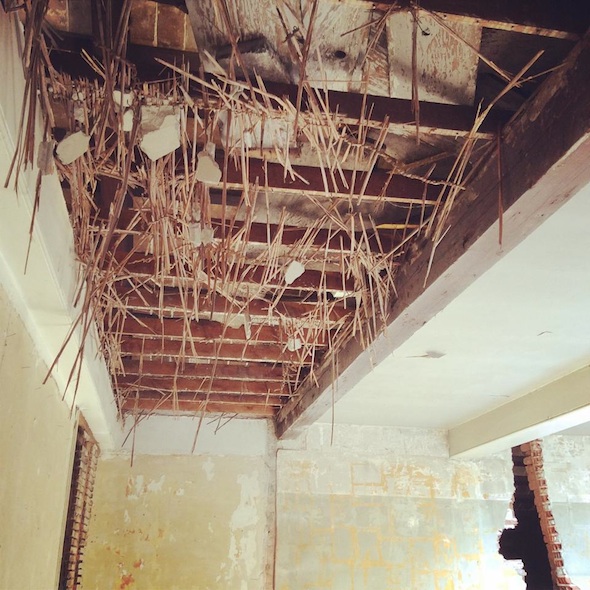 Florencia Costa – “Who’s Afraid of Architecture?,” Installation View; Photo by Alison Hugill
Florencia Costa – “Who’s Afraid of Architecture?,” Installation View; Photo by Alison Hugill
Brazilian architects Studio MK27 screen their films in a section of the Palazzo Mora. The office aims to put “architecture in motion,” by creating short films that explore the inner-workings of their designs. In the tradition of the black and white Bauhaus films made to show the ‘machines for living’ of Gropius, MK27 follow different characters – the maid and the housewife, or the cat, for example – in their daily navigations of the architecture. They have clearly devised a unique method of marketing their designs, which captivate despite their decidedly commercial angle.
Allowing the architecture offices to create both the content and curation of their displays has meant that, in many cases, marketing strategies have taken over. This has the predictable result of a largely banal exhibition, with very little critical or aesthetic thrust. While a few projects have pushed the boundaries, the potential for exhibition inherent in both Palazzo Mora and Bembo afford the TIME SPACE EXISTENCE exhibition the promise of so much more.
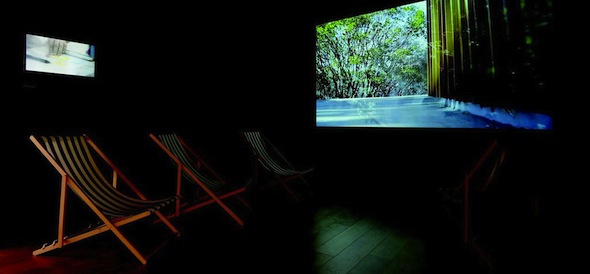 studio mk27, Installation view at Palazzo Mora, Venice Architecture Biennale, 2014. Photo: Global Art Affairs Foundation
studio mk27, Installation view at Palazzo Mora, Venice Architecture Biennale, 2014. Photo: Global Art Affairs Foundation
___________________________________________________________________________________
Additional Information
14th International Architecture Biennale
“TIME SPACE EXISTENCE” – GROUP SHOW
Exhibition: Jun. 7 – Nov. 23, 2014
Palazzo Bembo (click here for map)
Palazzo Mora (click here for map)
___________________________________________________________________________________
Alison Hugill has a Master’s in Art Theory from Goldsmiths College, University of London (2011). Her research focuses on marxist-feminist politics and aesthetic theories of community, communication and communism. Alison is an editor, writer and curator based in Berlin.






















